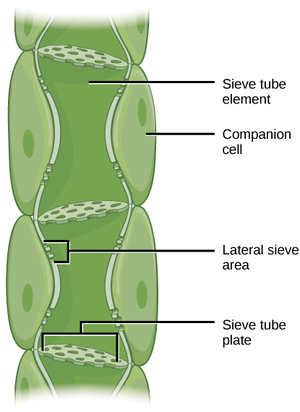Phloem
Contents
Key Stage 3
Meaning
The phloem is the tube in a plant which transports sugars from the leaf to the roots.
About the Phloem
- Phloem transports sugars in the leaves, made by photosynthesis, to other organs in the plant.
- Phloem is found next to the xylem tissue and together they make a plant vein.
- The process of sugar transport around the plant is known as translocation.
Key Stage 4
Meaning
The phloem is the tube in a plant which transports sugars from the leaf to the roots.
About the Phloem
- Phloem transports sugars in the leaves, made by photosynthesis, to other organs in the plant.
- Phloem is found next to the xylem tissue and together they make a plant vein.
- The process of sugar transport around the plant is known as translocation.
- Phloem is formed by phloem cells connecting the vacuoles of one phloem cell to the next. The cell wall between each phloem cell has small holes in it and is known as a sieve plate. The phloem cell lose many of their organelles, including mitochondria so they are supported by companion cells which keep them alive.
References
AQA
- Phloem, pages 10, 69, GCSE Biology, Hodder, AQA
- Phloem, pages 10, 69, GCSE Combined Science Trilogy 1, Hodder, AQA
- Phloem, pages 13, 62-65, GCSE Biology; Third Edition, Oxford University Press, AQA
- Phloem, pages 55, 72-3, 76-7, 86, GCSE Biology; Student Book, Collins, AQA
Edexcel
- Phloem, page 133, GCSE Biology, Pearson, Edexcel
- Phloem, page 49, GCSE Combined Science; The Revision Guide, CGP, Edexcel
- Phloem, pages 207, 213, GCSE Biology, CGP, Edexcel
- Phloem, pages 71, 73, GCSE Biology; The Revision Guide, CGP, Edexcel
